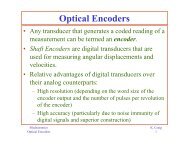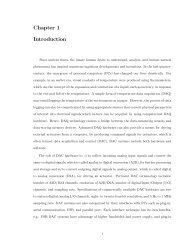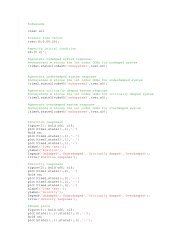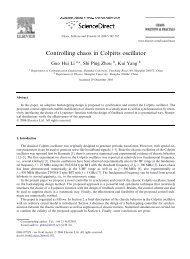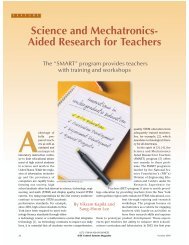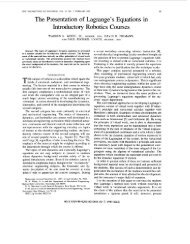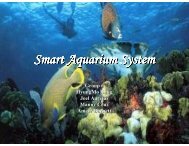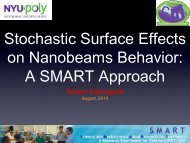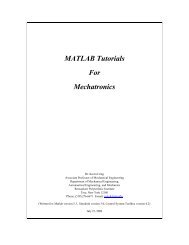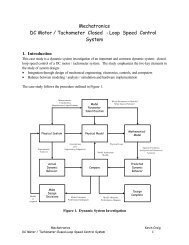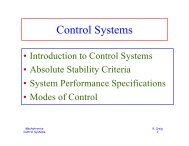EPA Nanotechnology and the Environment ... - Mechatronics
EPA Nanotechnology and the Environment ... - Mechatronics
EPA Nanotechnology and the Environment ... - Mechatronics
You also want an ePaper? Increase the reach of your titles
YUMPU automatically turns print PDFs into web optimized ePapers that Google loves.
<strong>Nanotechnology</strong> <strong>and</strong> <strong>the</strong> <strong>Environment</strong>: Applications <strong>and</strong> Implications STAR Progress Review Workshop<br />
Real-Time Chemical Composition Measurements of Fine <strong>and</strong> Ultrafine Airborne Particles<br />
Murray V. Johnston, University of Delaware<br />
As concern over health effects of ultrafine particles increases, new methods are needed to determine <strong>the</strong> composition<br />
of <strong>the</strong>se particles in air. The goal of this project is to develop a new technology that will determine chemical<br />
composition of airborne particles down to about 5 nm in diameter. Two problems that must be overcome are inefficient<br />
sampling of particles <strong>and</strong> inefficient analysis of those particles that have been sampled. The project has discovered that<br />
individual nanoparticles can be efficiently detected only if quantitatively converted to atomic ions.<br />
Session 2: Treatment<br />
Moderator: Y’Vonne Jones-Brown<br />
Nanoscale Biopolymers With Tunable Properties for Improved Decontamination <strong>and</strong> Recycling of Heavy Metals<br />
Wilfred Chen, University of California, Riverside<br />
The goal of this project is to develop high-affinity, nanoscale biopolymers with tunable properties for <strong>the</strong> selective<br />
removal of heavy metals such as cadmium, mercury, <strong>and</strong> arsenic. Conventional technologies often are inadequate to<br />
reduce concentrations in wastewater to acceptable regulatory levels. The project found that biopolymers with amino<br />
acid His 6<br />
or His 12<br />
tags can serve as a simple metal binding domain; both T t<br />
<strong>and</strong> metal binding capacity can be regulated<br />
easily, <strong>and</strong> biopolymers can be recycled. Metalloregulatory protein for mercury (MerR) can serve as a specific<br />
mercury-binding domain.<br />
Transition Metal Carbides as an <strong>Environment</strong>al Nanocatalyst<br />
S. Ismat Shah, University of Delaware<br />
Current catalytic converters will not be able to meet future emissions reduction targets without increasing <strong>the</strong><br />
amount of Pt-group precious metals to levels at which <strong>the</strong> converters might become prohibitively expensive. The goal<br />
of this research project is to investigate syn<strong>the</strong>sis, characterization, <strong>and</strong> application of nanoparticles of transition metal<br />
carbides <strong>and</strong> oxycarbides as replacements for <strong>the</strong> Pt-group metals. The project has found that tungsten carbide<br />
(WC 1-x<br />
) is a possible replacement for <strong>the</strong> Pt-group metals in automobile catalytic converters. WC 1-x<br />
nanoparticles<br />
were produced by reactive magnetron sputtering <strong>and</strong> were characterized for <strong>the</strong>ir chemistry <strong>and</strong> structure.<br />
Simultaneous <strong>Environment</strong>al Monitoring <strong>and</strong> Purification Through Smart Particles<br />
Wolfgang M. Sigmund, University of Florida<br />
The goal of this project is to investigate whe<strong>the</strong>r nano-engineered smart particles based on a modular building concept<br />
enable simultaneous monitoring <strong>and</strong> purification of water <strong>and</strong> air. The smart particles undergo visible change in color when<br />
a pollutant is present <strong>and</strong> are being developed to utilize magnetic <strong>and</strong> photocatalytic nanoparticles for treatment.<br />
Session 3: O<strong>the</strong>r Areas of Application<br />
Moderator: Nora Savage<br />
Plasmon Sensitized TiO 2<br />
Nanoparticles as a Novel Photocatalyst for Solar Applications<br />
George Chumanov, Clemson University<br />
The goal of this project is to develop a novel hybrid photocatalyst that consists of silver or gold nanoparticles<br />
encapsulated in a titanium dioxide (TiO 2<br />
) shell. TiO 2<br />
is environmentally friendly, relatively inexpensive, <strong>and</strong> a potentially<br />
efficient photocatalyst; however, wide technological use of this photocatalyst is largely hindered by <strong>the</strong> fact that<br />
ultraviolet light, which does not constitute a significant fraction of <strong>the</strong> solar spectrum, is required for its activation.<br />
Silver <strong>and</strong> gold are very efficient for capturing energy from <strong>the</strong> visible portion of <strong>the</strong> spectrum. In <strong>the</strong> initial research<br />
phase, a TiO 2<br />
shell on silver nanoparticles has been syn<strong>the</strong>sized.<br />
The Office of Research <strong>and</strong> Development’s National Center for <strong>Environment</strong>al Research 5



